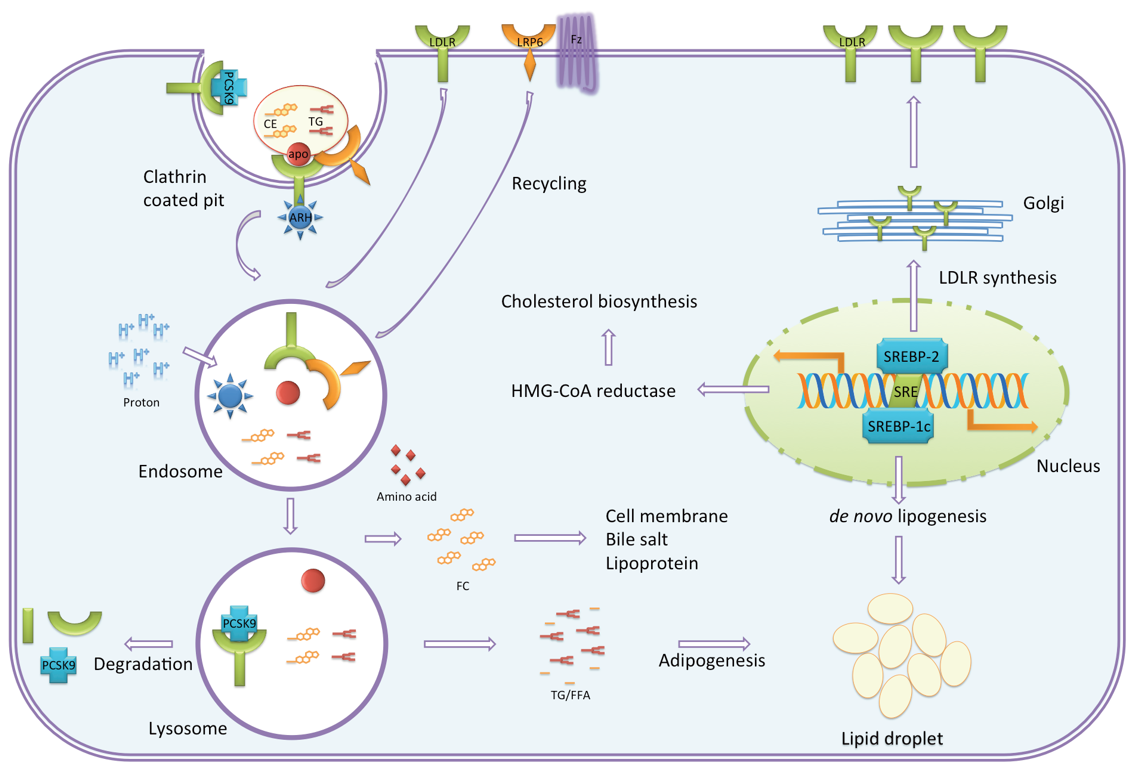
Our promise to you:
Guaranteed product quality, expert customer support.
 24x7 CUSTOMER SERVICE
24x7 CUSTOMER SERVICE
 CONTACT US TO ORDER
CONTACT US TO ORDER
LDLR Gene Editing 
The low-density lipoprotein (LDL) receptor (LDLR) is a membrane glycoprotein, which is responsible for the uptake and degradation of cholesterol-rich lipoproteins containing apolipoprotein B100 and E, especially LDL, by receptor-mediated endocytosis. In the central nervous system (CNS), LDLR is mainly located in the neurons, astrocytes, and oligodendrocytes. LDLR plays a significant role in regulating the homeostasis of the bloodstream and intracellular cholesterol. Mutations in the LDL receptor gene are the main cause of familial hypercholesterolaemia (FH), in which heterozygous type is one of the most common metabolic disorders, with a frequency of about 1/500 in most populations. Notably, in addition to those canonical functions, it has been reported that an increase in LDLR expression participated in limiting the deleterious proinflammatory signals of pathogens and improving prognosis among patients in sepsis and septic shock.
LDLR Function
LDLR is widely expressed and is a key receptor to maintain cholesterol homeostasis in mammals. The regulation of LDLR is implemented by sterol regulatory element binding proteins (SREBPs) and secreted proprotein convertase subtilisin-like/kexin type 9 (PCSK9) at the transcriptional and posttranscriptional levels, respectively. LDLR-mediated endocytosis is essential for lipid and lipoprotein metabolism. The clearance of LDL, a main carrier of cholesterol in human, by LDLR is extensively studied. IDL, VLDL, high-density lipoprotein (HDL), and chylomicron remnant are also recognized by LDLR at neutral pH. Receptor-ligand complexes undergo endocytosis through clathrin-coated pits. Coated vehicle dispenses to endosomes with LRP6 and autosomal recessive hypercholesterolemia protein (ARH), connecting the LDLR family protein and the endocytic machinery; therefore, acidic condition activates dissociation of internalized ligands. Released ligand particles further travel to the lysosome, in which the ligand is degraded by enzyme, while the receptors return to the cell surface. LDL particles trigger three steps after internalization: 1) reducing gene expression of 3-hydroxy-3-methylglutaryl-CoA reductase (HMGCR) to inhibit cholesterol biosynthesis; 2) enhancing the activity of acyl-CoA cholesteryl acyl transferase (ACAT) to reduce toxic free cholesterol; and 3) suppressing LDLR synthesis to reduce LDL uptake by SREBPs.
 Figure 1. Cellular cholesterol homeostasis. (Go G, Mani A., 2012)
Figure 1. Cellular cholesterol homeostasis. (Go G, Mani A., 2012)
LDLR and Disease
It has been confirmed that chronic inflammation could disrupt the LDLR pathway, leading to lipid disorders in atherosclerosis, diabetes, nonalcoholic fatty liver disease, and chronic kidney disease, while emerging studies have shown that LDLR in turn plays a crucial role in inflammatory reactions. The overexpression of LDLR by reducing PCSK9 function was associated with a decreased inflammatory cytokine response and improved septic shock outcomes in both mice and humans. Similarly, PCSK9 fortified atherosclerotic inflammation and cell apoptosis in an LDLR-dependent mechanism. In the brain, neuroinflammation of nerve cells was also shown to be mitigated in LDLR transgenic mice with Alzheimer's disease, implying that LDLR may be involved in regulating the sterile inflammatory process of brain tissues. In addition, LDLR could regulate NLRP3-mediated neuronal pyroptosis after cerebral I/R, suggesting the protective role of LDLR as an inflammatory mediator in ischemic stroke.
LDLR Gene Editing Services
CRISPR/Cas9 PlatformCB, one of the leading biotechnological companies specializing in gene editing, is dedicated to offering comprehensive CRISPR/Cas9 gene-editing services to a wide range of genomics researchers. Based on our platform, we can help you effectively LDLR gene deleted, inserted or point mutated in cells or animals by CRISPR/Cas9 technology.
- LDLR Gene Knockout: We offer LDLR gene knockout cell line and knockout animal model generation service with high quality. Typically, we develop CRISPR-mediated gene editing cell lines including HEK239T, Hela, HepG2, U87, but we can use other cell lines according to your requirements. Our one-stop KO animal model generation service covers from sgRNA design and construction, pronuclear microinjection to Founders genotyping and breeding.
- LDLR Gene Knockin: CRISPR/Cas9 PlatformCB provides the one-stop LDLR knock-in cell line and knockout animal model generation services, including point mutation and gene insertion. Our expert staff has succeeded in dozens of LDLR knock-in cell line generation projects, including stem cells, tumor cells and even difficult-to-handle cells. We also have extensive experience in incorporating CRISPR/Cas9 technology into animal models, which have been fully recognized by our clients.
If you have any questions, please feel free to contact us.
Related Products at CRISPR/Cas9 PlatformCB
References
- Silva S, Alves A C, Patel D, et al. In vitro functional characterization of missense mutations in the LDLR gene. Atherosclerosis, 2012, 225(1): 128-134.
- Sun R, Peng M, Xu P, et al. Low-density lipoprotein receptor (LDLR) regulates NLRP3-mediated neuronal pyroptosis following cerebral ischemia/reperfusion injury. Journal of Neuroinflammation, 2020, 17(1): 1-17.
- Go G, Mani A. Low-density lipoprotein receptor (LDLR) family orchestrates cholesterol homeostasis. The Yale journal of biology and medicine, 2012, 85(1): 19.